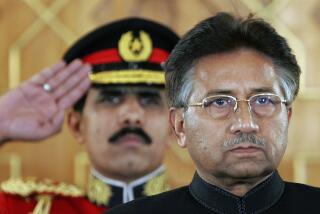Finessing Two Rivals Is Essential
- Share via
While flying to Pakistan last week on his mission to keep the coalition against terrorism together, Secretary of State Colin Powell couldn’t have been too pleased to hear that Indian forces had begun heavy shelling of Pakistani positions across the cease-fire line--the Line of Control--in the disputed territory of Kashmir.
Although Indian sources claimed their shelling was a response to Pakistani artillery several weeks ago, it was clear that the Indian actions were meant to coincide with Powell’s arrival in Pakistan and that they served a clear political purpose.
After Sept. 11, U.S. relations with South Asia changed dramatically. From having been an alienated military dictator, Pakistan’s president, Gen. Pervez Musharraf, became a brave ally, supporting the U.S. in spite of possible dire internal consequences. It is unlikely that any civilian Pakistani leader could manage what Musharraf appears to be pulling off: turning from actively supporting the Taliban in Afghanistan to participating in its destruction, thereby infuriating Pakistan’s small but powerful radical Islamic community.
Musharraf’s courage is being rewarded. As Powell held talks in Islamabad, the U.S. Congress was passing legislation to scrap all remaining sanctions on Pakistan, and hundreds of millions of dollars in aid were pledged to prop up the Pakistani economy.
One may ask why this should bother India. Wouldn’t a Pakistan that was economically healthy and cracking down on its Islamic extremists be a better and more stable neighbor? Unfortunately, South Asian politics is a zero-sum game. Whatever is good for Pakistan is seen as a setback for India and vice versa. So with U.S.-Pakistan relations warming up in a way unseen since the Cold War, Indian leaders concluded their emerging “partnership” with the U.S. was in jeopardy.
Such antipathy between two nations that have joined the coalition against terrorism poses a severe challenge to the U.S.-led effort. Should Indian-Pakistani tensions along the Line of Control continue to rise, Musharraf may find it impossible to rein in militant groups in his country, which could lead to the loss of a vital partner in the American campaign against the Taliban. India’s recent actions, therefore, are tantamount to a threat to the U.S. war on terrorism.
To keep the coalition together, the U.S. needs to keep peace in South Asia by following a two-pronged strategy.
First, the U.S. must step up international efforts to achieve some positive movement on the Kashmir dispute, sometimes termed the most dangerous conflict in the world. At the core of the dispute lies India’s claim that the Kashmir issue is an internal Indian issue and that the problem is Pakistani-engineered cross-border terrorism, ignoring United Nations resolutions that define Kashmir as a disputed territory and not exclusively Indian territory.
The U.S. must drive home to the South Asian antagonists the importance it attaches to resolution of the Kashmir issue. It must pressure Pakistan to cut its support for militants in Kashmir. It must explain to India that the violent suppression of deeply felt popular sentiments in the area can only further radicalize its population.
Second, the U.S. must underscore to both India and Pakistan that relations, even excellent relations, with one of them doesn’t preclude equally good relations with the other. U.S. policy must help break the zero-sum thinking deeply ingrained in the minds of the Indian and Pakistani elites.
Whereas the U.S. was visibly partial to India under President Clinton, the current administration has maintained an unbiased posture toward the two rivals, placing the U.S. in a good position to facilitate a dialogue.
More to Read
Get the L.A. Times Politics newsletter
Deeply reported insights into legislation, politics and policy from Sacramento, Washington and beyond. In your inbox three times per week.
You may occasionally receive promotional content from the Los Angeles Times.










